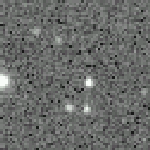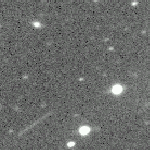FMO stands for "Fast Moving Object" and refers to asteroids moving so close to the Earth that the object appears as a trail in our image data. This event is created by the "close approach" of an NEA. The images below give a visual comparison of a distant asteroid versus an FMO. During a close approach, NEAs move so rapidly through the telescope's field of view during our exposure that their reflected sunlight blurs along a line (FMO). The two asteroids shown below are moving at similar absolute speeds in space (around 20 miles per second!), however the rate we perceive on Earth is very different. An analogy is an airplane observed at takeoff compared to a plane flying at 40,000 feet as seen from the ground. The farther away the aircraft is, the slower it appears to move.


The FMO pictured above is quite bright, but many FMOs appear as very faint trails. Faint trails of light are difficult to detect efficiently using software. In order to detect faint FMOs, the software must be tuned to see trails just above the background noise. Unfortunately, this tuning causes many image artifacts and electronic noise structures to be captured by the software as possible FMOs, leading to an enormous false detection rate - the observer must sift out the real FMOs from a multitude of fakes. Because of the high false detection rate, little or no time is saved by having software identify candidate FMOs. Combine this problem with the fact that the potential exists for the software to miss a real FMO and the advantages of using FMO detection software vanish. For SPACEWATCH® images, the most effective method of detecting FMOs is having the observer visually inspect all image data - a time intensive task.
SPACEWATCH® uses a 0.9m Kitt Peak telescope with a mosaic CCD system. This mosaic system increases the image data output to a degree that FMO inspections by the on-duty observer became impractical. Using funds provided by the Paul G. Allen Charitable Foundation, SPACEWATCH® used to conduct participation in the FMO review process by volunteers who wished to contribute to the scientific community's knowledge of small close-approaching NEAs. That program of participation is now closed.

